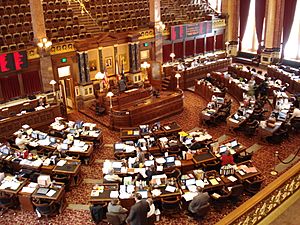Iowa Senate facts for kids
Quick facts for kids Iowa Senate |
|
|---|---|
| Iowa General Assembly | |
 |
|
| Type | |
| Type | |
|
Term limits
|
None |
| History | |
|
New session started
|
January 10, 2011 |
| Leadership | |
|
President of the Senate
|
Jack Kibbie (D)
Since January 8, 2007 |
|
President pro Tempore
|
Jeff Danielson (D)
Since January 8, 2007 |
|
Majority Leader
|
Michael Gronstal (D)
Since January 8, 2007 |
|
Minority Leader
|
Jerry Behn (R)
Since November 10, 2011 |
| Structure | |
| Seats | 50 |
|
Political groups
|
Democratic Party (26) Republican Party (23) |
|
Length of term
|
4 years |
| Authority | Legislative Department, Section 3, Iowa Constitution |
| Salary | $25,000/year + per diem |
| Elections | |
|
Last election
|
November 2, 2010 (25 seats) |
|
Next election
|
November 6, 2012 (25 seats) |
| Redistricting | Legislative Service Agency makes plan Iowa General Assembly passes plan |
| Meeting place | |
 |
|
| State Senate Chamber Iowa State Capitol Des Moines, Iowa |
|
| Website | |
| Iowa General Assembly | |
The Iowa Senate is an important part of the Iowa General Assembly, which is Iowa's law-making group. It's like the "upper house" of the state's government. There are 50 people in the Iowa Senate, called senators. Each senator represents a different area, or district, in Iowa. Each district has about 59,500 people.
Senators serve for four years. This is different from the Iowa House of Representatives, where members serve for two years. Every two years, half of the Senate members are elected. There is no limit to how many times a senator can be re-elected. The Senate meets at the beautiful Iowa State Capitol building in Des Moines.
Contents
Who Leads the Iowa Senate?
The main leader of the Senate is called the President of the Senate. This person is in charge of Senate meetings. They also decide which new laws go to different committees for review. Committees are small groups that study specific topics.
Before 1991, the Lieutenant Governor of Iowa was also the President of the Senate. But a change to the state's constitution separated these two jobs. Other important leaders, like the majority leader and minority leader, are chosen by their political parties.
How the Iowa Senate is Made Up
The Iowa Senate has 50 members. These members belong to different political parties. The party with the most members is called the "majority caucus." The table below shows how many members each party has had over the years.
| Group | Party
(the shaded color shows which party had the most members)
|
Total | |||
|---|---|---|---|---|---|
| Democratic | Republican | Independent | Empty Seats | ||
| End of 2012 | 26 | 23 | 0 | 49 | 1 |
| Start of 2013 | 26 | 24 | 0 | 50 | 0 |
| End of 2014 session | |||||
| Start of 2015 | 26 | 24 | 0 | 50 | 0 |
| End of 2016 session | 23 | 1 | |||
| Start of 2017 | 20 | 29 | 1 | 50 | 0 |
| End of 2018 | 50 | 0 | |||
| Start of 2019 | 18 | 32 | 0 | 50 | 0 |
| Latest voting share | 36% | 64% | 0% | ||
Famous Former Members
Many important people have served in the Iowa Senate before moving on to other big roles. Here are a few:
- Steve King: He later became a U.S. House Representative.
- Samuel J. Kirkwood: He was the Governor of Iowa two times. He also served as a U.S. Senator and even as the U.S. Secretary of the Interior.
- Tom Vilsack: He was the Governor of Iowa from 1999 to 2007. He also ran for President of the United States and is currently the U.S. Secretary of Agriculture.
- George A. Wilson: He served as Governor of Iowa from 1939 to 1943.
- George G. Wright: He was a U.S. Senator from 1871 to 1877.
- Patty Judge: She was the Iowa Secretary of Agriculture and later the Lieutenant Governor of Iowa.
Related Pages
- Iowa Senate at Ballotpedia
Images for kids



